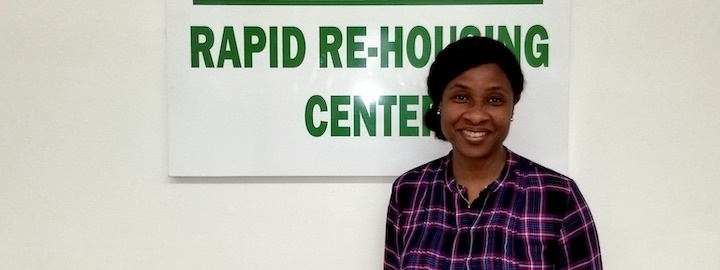
Leading from the front—Valerie C. Smith

I sat down with Valerie C. Smith a few short days ago to find out how the COVID-19 pandemic was affecting the vulnerable people Westhab serves and how our front-line staff are rising to meet this unprecedented challenge. After several days working from home, the conversation feels like it was a lifetime ago. But Ms. Smith, who is responsible for more than 1,000 of our clients living in NYC homeless shelters, does not have the option to work from home. She is a born leader, and her style is to lead from the front.
Ms. Smith is very matter of fact when discussing Westhab’s plan to weather the rapidly gathering storm that is COVID-19. She compares it to a winter storm. And, although the Antigua-born Smith does not like the cold very much, she knows how to handle a little snow: “We are running, status quo. We have adopted the plan that we normally would use when the city asks non-essential folks to stay home.” Of course, there are a couple of new wrinkles in the plan, including enforcing social distancing and implementing strict cleaning and disinfecting practices. The message she has for her staff is, “We are essential, and we are going to find a way to make this work.”
Ms. Smith is responsible for seven New York City shelters. Three of them serve families, three serve single men, and one serves single women. So far, Ms. Smith and her team have been able to maintain what she calls “business as usual.” However, like everyone else, the shelters are in need of cleaning supplies and are working (with some success) to stockpile emergency food for their clients.
“Our clients depend on us. We need to make sure that they are fed. We need to make sure that, if they are sick, the protocols are carefully followed. We are committed to making sure that we provide services.” ~Ms. Smith
To provide steady client meals in shelters where food is provided by an outside vendor, Ms. Smith is working closely with her suppliers to keep a three-day inventory on-site. For the shelters that serve families with children, where clients shop for and prepare their own food, Ms. Smith and her staff are stocking as many non-perishable items as possible in on-site emergency pantries, “in case families can’t get to the stores.”
But what happens when clients begin to fall ill with COVID-19? According to Ms. Smith, the NYC Department of Homeless Services (DHS) has been very responsive in providing protocols to the shelters for dealing with clients who begin to exhibit symptoms of the virus. “They are on it, ” she says. But “the issue is not what DHS says, it’s how it plays out in real life.” She adds, “We can call EMS, and they will come. But if the client, who has been coughing all day, decides he doesn’t want to go to the hospital, EMS can’t force them into the ambulance.” The fact is, clients are sometimes reluctant to leave the shelter for the hospital. Ms. Smith’s solution is to work closely with sick clients to build trust and to help them understand the potential severity of the illness. So far, her team has been able to overcome any resistance.
When asked if the pandemic was causing heightened levels of anxiety among the clients in the shelters, Mrs. Smith noted, “the clients are not paying a whole lot of attention to the growing crisis, and that is good and bad.” It is good because no one is panicking. The downside, Ms. Smith worries, is that not everyone is hearing the messages about safety that she and her team are loudly sending: “Do they hear that they need to wash their hands? Do they hear that if they have a cough, or a fever, or chills that they need to tell somebody?” So, she adds, “We have to be hyper-vigilant. If we see someone that doesn’t look well, we have to engage them. That’s the push.”
And when the situation gets worse, Ms. Smith has a plan. She says, “We have determined the fewest amount of staff we need to run each facility. They will be prepared to focus on safety and less on the day-to-day case management that normally goes on in the shelters.” She adds, “If we are running short in the front of the house, then people will have to work outside of their job scope. All of the program directors, the case managers, the security team, will make sure that we are staffing the buildings to keep everyone safe.”
If the public transportation system shuts down, Ms. Smith has a plan for that too. She is in the process of determining which staffers are comfortable driving Westhab’s fleet of vans, and she is putting a plan in place to transport staff—picking up people from strategic points, bringing them to work, and taking them back home. Ms. Smith adds matter-of-factly, “We have vans. We wipe down the vans. We take staff to work.”

